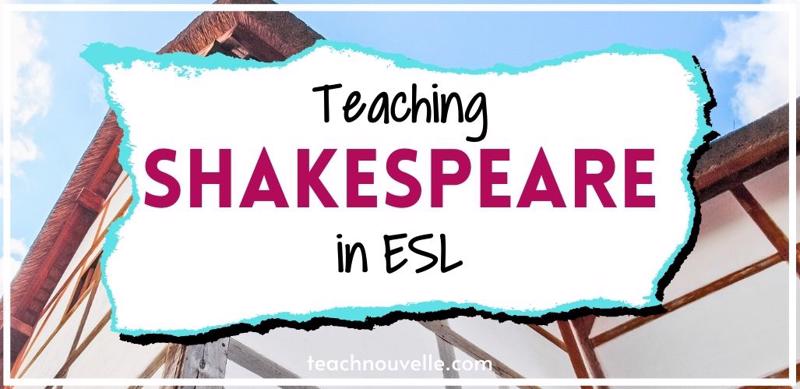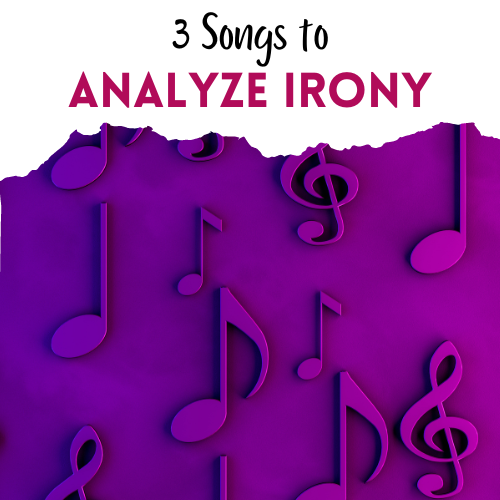My approach to teaching Shakespeare to ESL students will make it an engaging and accessible experience for teachers and students alike!
Teaching Shakespeare to ESL students (English Language Learners/ELLs) is an important consideration, particularly if you’re working in a pull out model. If students are studying Shakespeare in their regular ELA classrooms, teaching Shakespeare to ESL students can level the cultural playing field.
Now, I don’t think Shakespeare is the be-all, end-all of excellent writing. I’m not sure why students study a Shakespeare play every year of high school. However, I think that teaching the same thing to all students with appropriate academic support is the key to making all students feel like a community. Shakespeare isn’t something we should reserve for Honors students. Teaching Shakespeare to ESL students with appropriate supports is key to making them feel like part of the academic conversation at your school.
Goals for teaching Shakespeare to ESL students
- Build speaking and listening skills
- Leverage linguistic flexibility
- Increase student confidence
How do you make Shakespeare engaging?
With a focus on performance, we feel more like Shakespeare’s audience did in his time. At funny parts, we laugh. At sad parts, we cry. Building speaking and listening skills is a significant benefit of teaching Shakespeare to ELLs.
Start with improv.
I’ve talked before about using Improv in Secondary ELA, and here’s a free list of games I love. Improvisation is short, unprepared performance. It’s framed as a “game” and actors have to work together to meet an objective. I have used Improv in my ESL classrooms in France, Germany, and Puerto Rico. Each time, students have loved the opportunity to speak English in a game format. They love being goofy and spontaneous!
Tips for teaching Shakespeare’s language
When you’re teaching Shakespeare to ESL students, create a solid foundation for Shakespeare’s language. Here are some tips for teaching Shakespeare’s language, and here’s a Webquest I use to make it fun!
First, consider that all of your ESL students will have an advantage when presented with a glossary of popular words in Shakespeare. They already know one language and are learning another!
When you present the rhythm of iambic pentameter using this TED Talk from Akala, consider that your ELLs will already hear rhythm in language in a way that your native speaker students may not be able to articulate.
When we approach teaching Shakespeare to ESL students with some of these ideas in mind, we’re using asset-based thinking. By leveraging the linguistic skills they already have, we are making it easier for ELLs to access the texts.
Macbeth for ESL Students
Are you looking to teach a specific Shakespeare play in ESL? I have a whole collection of abridged Shakespeare plays called “Shakespeare in 30.” Students can perform each play can be in 30 minutes! For example, if you want to teach Macbeth for ESL students, the abridged version zooms in on Macbeth’s interactions with the witches.
What are the benefits of this approach?
- Students have a smaller script to tackle, meaning they can spend more time at sentence-level
- A narrow focus allows for deeper discussion
- They can actually perform a 30-minute script!
Because I love to get ESL students performing Shakespeare, I used a Staged Reading Approach. After we read the abridged play together as a class, students rehearse the lines and block out scenes, just like they would in a full production. They even bring in bits of costumes and props! The biggest difference is that students don’t need to memorize it, so they will have the security a script provides.
Shakespeare in ESL
Hopefully, you’ll try one of these ideas in your classroom this year! Teaching Shakespeare to ESL students is not an insurmountable challenge, and the scaffolds you put in place for ELLs can help everyone.
Let me know what other strategies you use to make Shakespeare engaging! Shout it out in the comments or reach out on IG @nouvelle_ela!
Happy teaching!







1 Comment
Kendra Vanessa Wilt
January 2, 2022 at 9:11 pmI agree with your all of your ideas for presenting, learning, and engaging ELL students in Shakespeare. Great way to make the most of it!!